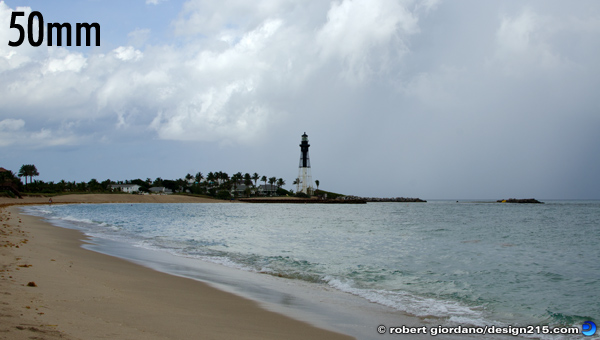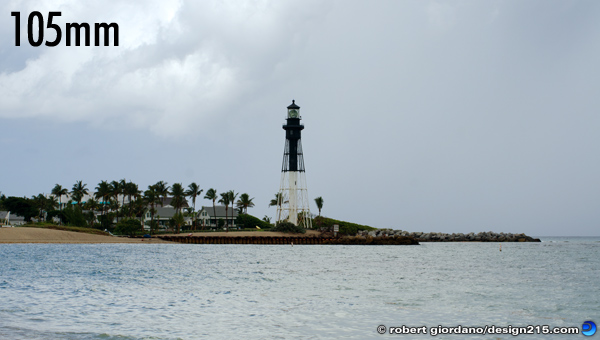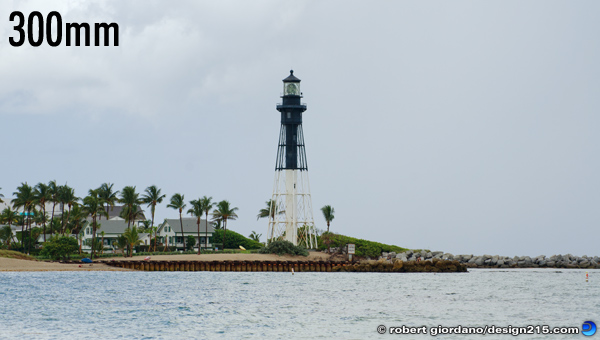v1.0, 2011-08-01 by Robert Giordano
This is an article about lenses for 35mm SLR and DSLR cameras. If you
are learning photography or you just want to have a better understanding
of different lenses and what to do with them, this guide is for you.
I will not go into the history of different lenses or some of the many
technical aspects of lenses that people obsess over.
If you have an SLR or DSLR (Single Lens Reflex or Digital Single Lens
Reflex) camera, it means you can attach various lenses to the front
of it. It means that when you look through the viewfinder, you are actually
looking through the lens. There are many, many lenses you can use with your
camera. The question is, which one is the right one? The answer to this question
will change depending on what you are taking pictures of, if the subject is
moving or not, what time of day it is, and of course, your budget.
The first thing to learn is how lenses are named. The name of each lens
tells you its Focal Length and widest Aperture. Along with these two critical
pieces of information, are other letters and numbers that vary by manufacturer
and describe extra features like auto focus. Here are a few examples of lens
names (without the extra letters added by manufacturers):
50mm f/2.8
100mm 1:2.5
24mm f/2.8
12-24mm f/4
70-200mm f/3.5-4.5
The Focal Length comes first and is always expressed in Millimeters (mm).
The Aperture comes next and is either expressed as an "F" number (usually
written as a fraction, f/2.8) or a ratio like 1:2.8. When professional
photographers talk about their lenses, they will say the Focal Length and
the Aperture like, "Hey, did you see my new 105 F2? Its Amazing!" If you
are a photographer's assistant, you have to be familiar with the names of
the lenses a photographer has in his bag so when he says, "I need the 24" you
know that he means his 24mm lens. If the photographer only has ONE 24mm lens
in his bag (which will be 99.9% of the time), they usually won't bother to say
the F number.
The Focal Length is a measurement. It is roughly the distance between the
film or digital sensor in the camera, and the center of the main glass element
inside the lens. I say "roughly" because the exact distance is calculated using
the "rear nodal point" of the lens but I promised not to get into lengthy technical
stuff. All you really need to know is that bigger Focal Lengths mean more magnifying
power and smaller Focal Lengths mean a wider angle of view. A 50mm lens represents
the middle or "normal" view where objects in the camera appear the same size as
when you're looking at them without a camera. If you really want to get into all
of the technical stuff, the following page is a good starting point:
http://en.wikipedia.org/wiki/Focal_length
Lenses are available in many other Focal Lengths. A "Zoom" lens is one that can be adjusted anywhere
between two different focal lengths. A "Prime" lens is one that is set at a fixed focal length and
cannot zoom in or out. It would be awesome if there was one lens that you could adjust anywhere between
18mm and 600mm, but due to the current methods of lens construction, this isn't possible or practical.
I used to have an expensive 18-200mm zoom lens (18mm to 200mm) and although it was
really handy, my separate 24mm and 180mm prime lenses produced better quality images.
I photographed the following scene with a number of different lenses. The camera
was on a tripod and was not moved between shots. The focal length of the lens is
given at the top of each image.






The second distinguishing feature of a lens is its widest Aperture. This is
given as an "F" number like f/2.8 or as a ratio like 1:2.8. Again, I'd like to
skip as much technical jargon as possible. This number tells you how much light
a lens will let into the camera. The LOWER the number, the MORE light it will
let in. It REALLY HELPS to think of the F number as a ratio! For example 1:1 would
let in ALL the light, while 1:2 would only let in half the light, and 1:4 only lets in
a quarter of the light. While the actual math is a bit more complex, this should simplify
things for you.
On most lenses, you can set the aperture to a number of different "F-Stops"
to let in LESS light, but you can't make a lens take in more light than its
widest aperture. Let's say you had a choice between a 200mm f/4 and a 200mm f/2.8.
The 200mm f/2.8 would generally be a much better lens. It might also cost twice as
much because the glass elements would be twice as big, in order to let in twice as
much light.

The Aperture Chart shows various apertures drawn to scale. As you can see,
the LOWER F-Number represents the WIDER Aperture, which lets in MORE light.
The following is a list of all the F-Stops you are likely to see on 35mm lenses:
f/1.4, f/2, f/2.8, f/4, f/5.6, f/8, f/11, f/16, f/22
Why should you want an f/2.8 lens instead of an f/4 lens? (or an f/4 instead
of an f/5.6, etc.) Why do you want to let in more light? Since each F-stop in
the above chart lets in TWICE as much light as the one after it, an f/2.8 lens
lets in twice as much light as an f/4 lens. This means you can use a shutter
speed that's twice as fast with your f/2.8 lens. This is good for shooting
sports where things are moving fast. It also means you can shoot pictures
when there isn't as much available light. This is good for shooting concerts
or events at night when you may not be able to use a flash. This is why sports
photographers always have those big huge lenses. They need lenses that let in
as much light as possible so they can use faster shutter speeds and they can
shoot games at night where stadium lighting isn't as bright as sunlight.
A wider aperture also decreases the Depth-of-Field. In other words, it makes
the background more blurry. Fashion photographers like this because it separates
the model from the background. It also makes flat photographs look more
three-dimensional. Food is often photographed with an f/2.8 or f/2 lens so
that only a small detail of the food is actually in focus.
Cheaper zoom lenses may have an aperture range like f/4.5-5.6. When this lens
is set to its smallest focal length, you'll have a maximum aperture of f/4.5.
When set to its longest focal length, you'll only have a maximum aperture of
f/5.6. That's not very good. Better quality zoom lenses will have a consistent
maximum aperture throughout their zoom range. If you like math and you want to
learn how F-Numbers are calculated and all of that stuff, see
http://en.wikipedia.org/wiki/F-number.
There is one last point to consider. Because lenses with smaller F-numbers
have to be made with larger pieces of glass, they also have to be made with
greater precision and higher tolerances. This is why an f/2.8 lens is more
expensive than an f/4 but it is also why the f/2.8 lens might produce sharper,
better quality images. While this isn't true in every case, I've experienced it
more often than not. Having a greater range of creative control is an important
detail to any artist. It is why a painter will pay twice as much for one type
of brush as opposed to another. It is why a photographer will pay more for an
f/2.8 lens than an f/4 lens.
The sensor in many DSLRs is smaller than 35mm film. Its called the APS-C image
sensor format. Nikon calls it the DX format while Canon calls it EF-S or APS-C.
When you put a 50mm lens on an APS-C format camera, the image will look like
you shot it with a 76mm lens. Why? Because the sensor is smaller than 35mm film,
you are only getting the center section of the 35mm image that the lens is capturing.
To find the equivalent of a 35mm lens on an APS-C format camera, multiply the
Focal Length by 1.5. For example, a 20mm lens becomes a 30mm lens. This is not
good news when you need a wide angle lens. The best wide angle lens I've used is
Nikon's 12-24mm f/4 which gives me the equivalent of an 18-36mm lens on a 35mm
film camera. On the other hand, my 200mm lens becomes a 300mm and my 300mm lens
becomes a 450mm. As you can see, there are advantages and disadvantages to the
APS-C format. Some lenses are specifically designed for APS-C cameras. While
they might also fit on a 35mm film camera of the same brand, they will usually
vignette. Full frame 35mm digital cameras are available but they are generally
a lot more expensive.

I've been asked this question so many times that I decided to make the following list...
(I only use Nikon cameras and lenses so all of the examples are Nikon)
If you're a A _______,
you should have B _______
for example, C _______
because D _______
A. Photojournalist
B. 2 camera bodies, one with a wide angle zoom lens and the other with a telephoto zoom lens, one
external flash, a notepad and a car charger for your cell phone.
C. Nikon 17-35mm f/2.8 and Nikon 80-200mm f/2.8
D. you need to have a minimal amount of gear you can keep with you 24 hours a day. You'll need a wide
angle lens for entire scenes, and a telephoto lens to get crime scene photos from a safe distance. You'll
need two camera bodies because you'll be shooting the action as its happening and you won't have time to
change lenses on a single camera body. You'll need a notepad to write down the captions that your editor
will demand from you later. You'll need to keep your cell phone charged at all times.
A. Landscape/Travel Photographer
B. 1 camera body, and an assortment of prime lenses, a good tripod, and survival gear.
C. Nikon 10.5mm f/2.8 fisheye, Nikon 12-24mm f/4, Nikon 20mm f/2.8, Nikon 35mm f/1.8, Nikon 50mm f/1.8,
Nikon 105mm f/2.8
D. the landscapes aren't going anywhere so you have time to select the right lens for the scene, and prime
lenses will provide sharper details, especially if you want to make prints larger than 8 x 10. You'll need the
tripod if you want to shoot long exposure scenes at night. You'll need survival gear because you'll be out in
the middle of nowhere, sleeping on the ground so you can get that amazing shot at 5am.
A. Fashion Photographer
B. 2 camera bodies, several normal to telephoto prime lenses, an assistant, and an agent.
C. Nikon 85mm f/1.8, Nikon 180mm f/2.8, Nikon 300mm f/2.8
D. you'll need to use longer focal length lenses to make the models look as good as possible. You'll
need an assistant because you have to give these models your full attention. You'll need an agent because,
out of the 3,000,000 photographers that want this job every year, maybe 10 get paid to do it.
A. Concert/Club Photographer
B. 2 camera bodies, one with a wide angle zoom lens and the other with a telephoto zoom lens, one external
flash, and a notepad.
C. Nikon 12-24mm f/4 and Nikon 80-200mm f/2.8
D. you'll want the minimal amount of gear because you could be on your feet for 6 to 12 hours straight,
depending on the length of the event/concert/rave/etc. You'll want the widest angle lens you can get for
impressive shots of the crowd, as well as a good telephoto for shots of the band/performer/DJ/etc. You'll want
two camera bodies because you won't want to switch lenses back and forth a million times during the show. You'll
want a flash to get photos of hot girls/guys/whatever in the crowd and you'll need a notepad to write down their
phone numbers.
If you're a serious photographer, you should really strive to have the best
set of lenses you can afford. Camera bodies come and go, and they are always
being updated. That $1600.00 camera body you buy today might be obsolete in a
few years but your 80-200mm f/2.8 can serve you for a lifetime if take good care
of it. You can take a great picture with a cheaper camera body and an excellent
lens, but the fanciest, most expensive camera will still take a mediocre picture
with a cheap lens.
Please leave comments below if you found this article helpful, if you spot any
errors, or if you think I should add anything else.
thanks!
16 Nov 2016 1:00am
"Oh my goodness you explain everything so very well, clear but very technical or should i say thorough.. I have "taken photo's" for years, learnt a little with my 'film' camera but old age says it's too hard just push the button... I've tried to retain -what you have just explained so clearly - for so many years... Sorry I am very happy to of found your page and can't wait to do more reading.. THANK YOU No really THANKS XXXX"
26 Oct 2012 11:10pm
"Very helpful! I am fairly new to photography and have not found a better tutorial than this anywhere! The pictures that are provided with the information really brings the lesson to life for me because it make is so much easier to understand. I have a much clearer idea of the basics and what camera + camera lens to look for when i go buy my equipment, Thank you very much!"
29 Jun 2012 5:58pm
"This was very helpful! Thanks for laying it out so simply, especially with the photos demonstrating the different lenses. I have just upgraded to a NEX5N from compact cameras, and this article will help me choose some vintage lenses to go with it. Thanks very much!"